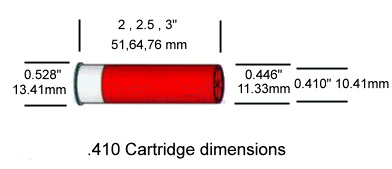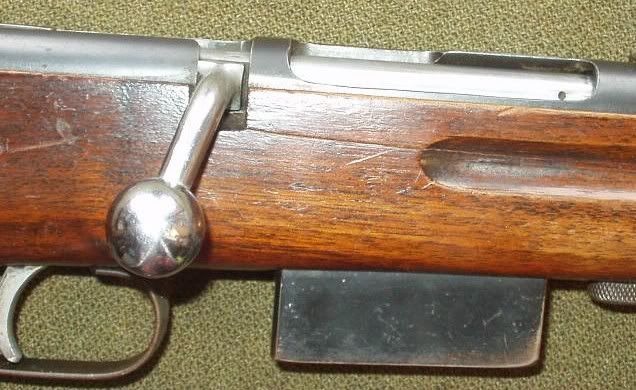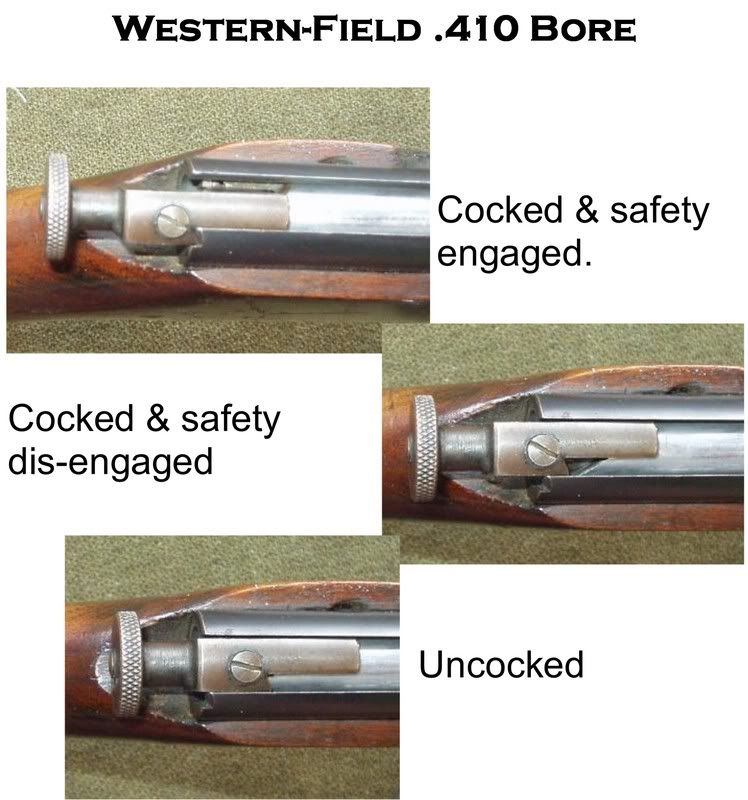
I present for your approval one each bolt action shotgun, made for Montgomery Wards, in .410 bore and that before the 3" .410 was at all widely accepted. This gun was bought (used I think) by Grandpa and Dad used it to kill his first squirrel. There's a pic of him with the gun, somewhere.
For certain this gun will win no awards for beauty, grace, or style, but it is a dependable gun having been in use for about 80 years. Made at a time when serial numbers weren't required and guns like this were basic commodities, this gun has no serial. Never transferred, it has never needed one. Again, it has the 2-1/2" chamber but I know that Grandpa used 3" shells in it. He said it kicked a bit more and that it wouldn't feed from the magazine. Feeds just fine with the 2-1/2" stuff of course. The story of this gun is intimately involved with that of the .410 bore cartridge.
 The .410 bore, often incorrectly called ".410 gauge", is the smallest commonly available shotgun shell. .410 is the only popular shotgun cartridge named by bore rather than gauge, leading to some confusion. Base dimensions are roughly similar to the .45 Colt revolver cartridge but it is up to 3 inches in length which allows many single-shot firearms (such as the Thompson-Center Contender) and some revolvers (like the Taurus) chambered in .410 to use .45 Colt ammo. Many years ago it was also called the 36 gauge, Remington boxes of these shells can be found marked "(36 GA.) .410-2 1/2 IN. (12 MM)." However, the "36 Gauge" designation was very inaccurate, as a true 36 gauge gun would actually have a .506 inch bore diameter. They are available in 2 1/2 inch length containing 1/2 ounce of shot, and 3 inch length with 11/16 ounce of shot. The high brass 3 inch shell used to contain 3/4 ounce of shot, but was reduced to 11/16 ounce a few years ago. There is also a 1/5 ounce (around 86 grains) Foster type rifled slug load available for the .410 shotgun with a velocity of 1830 fps.
The .410 bore, often incorrectly called ".410 gauge", is the smallest commonly available shotgun shell. .410 is the only popular shotgun cartridge named by bore rather than gauge, leading to some confusion. Base dimensions are roughly similar to the .45 Colt revolver cartridge but it is up to 3 inches in length which allows many single-shot firearms (such as the Thompson-Center Contender) and some revolvers (like the Taurus) chambered in .410 to use .45 Colt ammo. Many years ago it was also called the 36 gauge, Remington boxes of these shells can be found marked "(36 GA.) .410-2 1/2 IN. (12 MM)." However, the "36 Gauge" designation was very inaccurate, as a true 36 gauge gun would actually have a .506 inch bore diameter. They are available in 2 1/2 inch length containing 1/2 ounce of shot, and 3 inch length with 11/16 ounce of shot. The high brass 3 inch shell used to contain 3/4 ounce of shot, but was reduced to 11/16 ounce a few years ago. There is also a 1/5 ounce (around 86 grains) Foster type rifled slug load available for the .410 shotgun with a velocity of 1830 fps. About 1904 the cartridge makes its appearance in catalogs and English proof houses. No one today knows who invented it. There is a good amount of speculation that the .410 was originally a rifle caliber, similar to the .444 Marlin. This might well be true, due to the rather recent discovery of older "rook rifles" that were originally rifles that were converted to shotgun use. The .410 shotshells originally came as a 2 inch cartridge. As time went on, the shell was expanded to 2 1/2 inches and a 3 inch cartridge, which was a move to accommodate more shot. With such a small shot charge, the .410 was originally intended to be a taxidermist's gun and "pot shooter". A pot shooter was a gun used to gather meat for the family pot. Again, since the shot charge was so small, there were less pellets that would damage the meat or specimen. What changed all of this was the recreational activity of skeet shooting. Skeet shooting is a clay target game shot with shotguns. As the game became more and more popular, the .410's success was assured.
About 1904 the cartridge makes its appearance in catalogs and English proof houses. No one today knows who invented it. There is a good amount of speculation that the .410 was originally a rifle caliber, similar to the .444 Marlin. This might well be true, due to the rather recent discovery of older "rook rifles" that were originally rifles that were converted to shotgun use. The .410 shotshells originally came as a 2 inch cartridge. As time went on, the shell was expanded to 2 1/2 inches and a 3 inch cartridge, which was a move to accommodate more shot. With such a small shot charge, the .410 was originally intended to be a taxidermist's gun and "pot shooter". A pot shooter was a gun used to gather meat for the family pot. Again, since the shot charge was so small, there were less pellets that would damage the meat or specimen. What changed all of this was the recreational activity of skeet shooting. Skeet shooting is a clay target game shot with shotguns. As the game became more and more popular, the .410's success was assured. I believe my gun was made for Montgomery Wards (now defunct but a long time mail order business) by Mossberg. You will see the similarities between this shotgun and the Model 40 rifle I have. Both use the same action albeit modified for the particular application. The 25-1/2" barrel on the gun is unmodified. You can see that rust has been present in the past. The front sight is a bead and there is a rear sight in the form of a broad "U". As you can see in the photo to the left, there is a strong crack in the stock. I don't know that this comes from shooting as this is an unstressed portion of the stock.
I believe my gun was made for Montgomery Wards (now defunct but a long time mail order business) by Mossberg. You will see the similarities between this shotgun and the Model 40 rifle I have. Both use the same action albeit modified for the particular application. The 25-1/2" barrel on the gun is unmodified. You can see that rust has been present in the past. The front sight is a bead and there is a rear sight in the form of a broad "U". As you can see in the photo to the left, there is a strong crack in the stock. I don't know that this comes from shooting as this is an unstressed portion of the stock.  The action is extremely simple, locking with the bolt handle root and using a single strong spring as the ejector as you can see in this photo of the action from the top. The single-column magazine holds just 2 more rounds. With one in the chamber, this is a 3 shooter, max legal capacity for shotguns used on migratory game for a long time now. As I said before it is chambered for the 2-1/2" shell. While my grandpa shot 3" shells in it I don't suggest that anyone else do the same and I've accumulated some 2-1/2" ammo specifically for the gun. The safety is simplicity, one simply turns the big knob on the striker so that the hook on it engages in the receiver for safe, out for fire as shown in this last photo.
The action is extremely simple, locking with the bolt handle root and using a single strong spring as the ejector as you can see in this photo of the action from the top. The single-column magazine holds just 2 more rounds. With one in the chamber, this is a 3 shooter, max legal capacity for shotguns used on migratory game for a long time now. As I said before it is chambered for the 2-1/2" shell. While my grandpa shot 3" shells in it I don't suggest that anyone else do the same and I've accumulated some 2-1/2" ammo specifically for the gun. The safety is simplicity, one simply turns the big knob on the striker so that the hook on it engages in the receiver for safe, out for fire as shown in this last photo. 
Links:
The mythical 36 gauge
Chuck Hawks
No comments:
Post a Comment
I only ask that you keep it clean and not spam readers. Thanks.